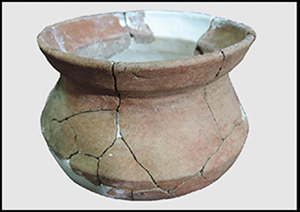19 results in South and Southeast Asian Archaeology
Taphonomy and labour at the Indus Valley site of Harappa (3700–1300 BC)
-
- Published online by Cambridge University Press:
- 06 December 2024, pp. 83-100
- Print publication:
- February 2025
-
- Article
-
- You have access
- Open access
- HTML
- Export citation
Deconstructing the ‘Gandhāra still’: a new challenge to the accepted trajectory of early distillation technology
-
- Published online by Cambridge University Press:
- 24 October 2024, e5
- Print publication:
- February 2025
-
- Article
-
- You have access
- HTML
- Export citation
Restitution and repatriation as an opportunity, not a loss: some reflections on recent Southeast Asian cases
-
- Published online by Cambridge University Press:
- 20 September 2024, pp. 1395-1405
- Print publication:
- October 2024
-
- Article
-
- You have access
- Open access
- HTML
- Export citation
Isotopic and provenance analysis of Neolithic and Bronze Age shell disc beads from Ban Non Wat, north‐east Thailand
-
- Published online by Cambridge University Press:
- 27 August 2024, pp. 905-919
- Print publication:
- August 2024
-
- Article
-
- You have access
- Open access
- HTML
- Export citation
Aggrandisers and the first copper-base metallurgy in Southeast Asia
-
- Published online by Cambridge University Press:
- 12 February 2024, pp. 433-453
- Print publication:
- April 2024
-
- Article
-
- You have access
- Open access
- HTML
- Export citation
Shark-tooth artefacts from middle Holocene Sulawesi
-
- Published online by Cambridge University Press:
- 24 October 2023, pp. 1420-1435
- Print publication:
- December 2023
-
- Article
-
- You have access
- Open access
- HTML
- Export citation
Different strategies in Indus agriculture: the goals and outcomes of farming choices
-
- Published online by Cambridge University Press:
- 11 September 2023, pp. 1488-1500
- Print publication:
- December 2023
-
- Article
-
- You have access
- Open access
- HTML
- Export citation
Sequins from the sea: Nautilus shell bead technology at Makpan, Alor Island, Indonesia
-
- Published online by Cambridge University Press:
- 15 August 2023, pp. 810-828
- Print publication:
- August 2023
-
- Article
-
- You have access
- Open access
- HTML
- Export citation
Social distinctions during the south Indian Neolithic: changing mortuary practices in a late prehistoric cemetery at Maski
-
- Published online by Cambridge University Press:
- 27 June 2023, pp. 887-907
- Print publication:
- August 2023
-
- Article
-
- You have access
- Open access
- HTML
- Export citation
Ethnoarchaeology of foreign coins in India: reinterpreting Venetian ducat design, and implications for archaeonumismatics
-
- Published online by Cambridge University Press:
- 15 February 2023, e11
- Print publication:
- April 2023
-
- Article
-
- You have access
- Open access
- HTML
- Export citation
In search of a musical past: evidence for early chordophones from Vietnam
-
- Published online by Cambridge University Press:
- 21 February 2023, pp. 141-157
- Print publication:
- February 2023
-
- Article
-
- You have access
- Open access
- HTML
- Export citation
Early settlement construction in Southeast Asia: lime mortar floor sequences at Loc Giang, southern Vietnam
-
- Published online by Cambridge University Press:
- 08 December 2022, pp. 1538-1554
- Print publication:
- December 2022
-
- Article
-
- You have access
- Open access
- HTML
- Export citation
The ‘Madrasien’: on the trail of a terminology in Indian prehistory
-
- Published online by Cambridge University Press:
- 28 October 2022, pp. 1443-1459
- Print publication:
- December 2022
-
- Article
- Export citation
Tropical island adaptations in Southeast Asia during the Last Glacial Maximum: evidence from Palawan
-
- Published online by Cambridge University Press:
- 01 August 2022, pp. 1072-1086
- Print publication:
- October 2022
-
- Article
- Export citation
Preceramic riverside hunter-gatherers and the arrival of Neolithic farmers in northern Luzon
-
- Published online by Cambridge University Press:
- 01 June 2022, pp. 848-867
- Print publication:
- August 2022
-
- Article
-
- You have access
- Open access
- HTML
- Export citation
Grounding texts and theories of societal change
-
- Published online by Cambridge University Press:
- 29 March 2022, pp. 611-627
- Print publication:
- June 2022
-
- Article
-
- You have access
- Open access
- HTML
- Export citation
Refining the chronology and distribution of mid-fifteenth to mid-seventeenth century Indian Ocean world glass
-
- Published online by Cambridge University Press:
- 18 October 2021, e35
- Print publication:
- December 2021
-
- Article
-
- You have access
- HTML
- Export citation
Re-evaluating Pleistocene–Holocene occupation of cave sites in north-west Thailand: new radiocarbon and luminescence dating
-
- Published online by Cambridge University Press:
- 08 October 2021, pp. 280-297
- Print publication:
- April 2022
-
- Article
-
- You have access
- Open access
- HTML
- Export citation
The Palaeolithic stone assemblage of Kota Tampan, West Malaysia
-
- Published online by Cambridge University Press:
- 01 September 2020, e25
- Print publication:
- October 2020
-
- Article
-
- You have access
- HTML
- Export citation




















